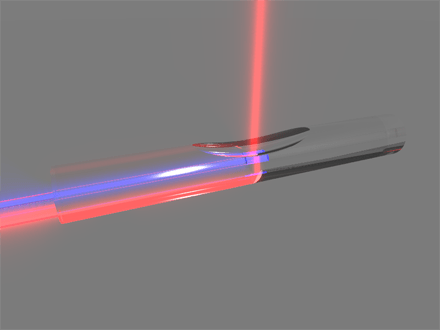HANNOVER, Germany, April 14, 2016 — A technique based on optical interferometry could enable ultrasonic methods to be used internally to gather information about the heart tissue. Until now ultrasonic methods have only been used externally, because the piezo electronical components necessary for internal use have not been sufficiently miniaturized to be inserted into the blood vessels.
A group of researchers at the Laser Zentrum Hannover eV (LZH) and the Technion-Israel Institute of Technology are working on an optoacoustical sensor for medical ultrasonic technology that could enable intravascular exams. The technology, based on optical interferometry, will allow an intravascular module to be equipped with an optoacoustical imaging sensor, providing an internal image of the tissue of the coronary blood vessels up to a depth of 1 mm.
 To achieve this, a guided laser impulse from an illuminating fiber is first absorbed by the blood vessel tissue. The resulting ultrasonics are then guided to a fiber-based ultrasonic detector via an acoustical lens. By transforming this signal into an optical signal, a complete image of the vascular walls can be made. An optical interferometer recognizes deviations in the reflection pattern, making the detection of abnormal or disease-based changes in the tissue possible.
To achieve this, a guided laser impulse from an illuminating fiber is first absorbed by the blood vessel tissue. The resulting ultrasonics are then guided to a fiber-based ultrasonic detector via an acoustical lens. By transforming this signal into an optical signal, a complete image of the vascular walls can be made. An optical interferometer recognizes deviations in the reflection pattern, making the detection of abnormal or disease-based changes in the tissue possible.
The optoacoustical sensor consists of an ultrasonics-generating lighting fiber, an acoustical lens and an ultrasonic detector element. Courtesy of Laser Zentrum Hannover eV.
The scientists in the Laser Micromachining Group at LZH are developing the process engineering necessary for the production of the acoustical lenses. These will be inserted directly into the glass substrate. In order to do so, specific areas of the substrate will be removed first using the laser, and then polished.
Further parts of the intravascular sensor module, apart from the lens, are an ultrasonic detector element and a lighting fiber for ultrasonic stimulus. The design and conversion of the signals into an image that can be used for diagnostics is being developed by the scientists at Technion.
Intravascular examinations will give physicians a more detailed image of the vessel than can be achieved using external investigation methods, improving cardiological diagnostics. The optoacoustical sensor should have a significantly higher sensitivity and resolution, in comparison to present methods, making the diagnosis of heart disease more straightforward.
LZH is is an independent, nonprofit research institute engaged in R&D and consulting in the fields of photonics and laser technology. For more information, visit www.lzh.de/en.